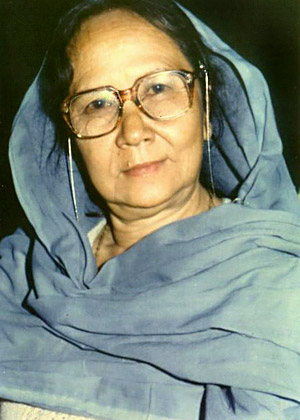 Maharaj Kumari Binodini Devi was born on February 6th in the year 1922. She is the youngest daughter of the late Maharaj Sir Churachand Singh and Maharani Dhanamanjuri. As education for girls was a taboo in those days she received her early education through tutors like the late Waikhom Selungba and Mrs. Jolly in her childhood. She was later sent to Pine Mount School where she received a formal school education.
Maharaj Kumari Binodini Devi was born on February 6th in the year 1922. She is the youngest daughter of the late Maharaj Sir Churachand Singh and Maharani Dhanamanjuri. As education for girls was a taboo in those days she received her early education through tutors like the late Waikhom Selungba and Mrs. Jolly in her childhood. She was later sent to Pine Mount School where she received a formal school education.
She completed her college from Shillong at St. Marys` College and was later transferred to Vidyasagar College, West Bengal. She studied art at Vishwabharati University in Shantiniketan. It was at the Kala Bhavan where she started her studies in the field of sculpture and painting and was well known in the field.
She was also under the tutelage of renowned Gurus Ramkinkar Vaij and Nandalal Bose.
She became fluent in English, Hindi and Bengali as well as in the field of Arts. Thereafter she got married to Doctor Laiphungbam Nandababu Roy.
She has written short stories, song lyrics. Her work was liked by the people. In 1965 her play "Asangba Nongjabee" was performed and produced as a radio-play. Later it also became a part of a published collection of plays titled "Nungairakta Chandramukhi" which brought her to the attention of the world of literature.
In 1976 she released her first novel that was based on the true story of a Manipuri princess, daughter of Maharaj Surchandra Singh, known as "Boro Saheb Ongbi Sanatombi". She received several awards including Sahitya Akademi Award and State Kala Akademi Award, Manipur. She was also honoured with the Padmashree by the Indian Government for her contribution to literature and arts. Another book released by her called "Amasung Indrajit" which was a translation of a novel by Badal Sircar.
She has been the secretary of Jawaharlal Nehru Manipur Dance Academy for 16 years during the 70s and 80s. A travelogue named "Ho Mexico" has been composed by her. In 2008 she was awarded the "Ningombam Pramodini Literature Award" and in 2009 she was awarded "Seram Mukta Award". She is also known for her script writing. Among her memorable contribution in this direction in the area are "Olangthagee Wangmadasoo", "Eshanou", "Imagi Ningthem" and "Sagol Sanaabi".
Binodini campaigned hard for the preservation of the Manipur culture. She has been supporting the traditional arts and artistes. She also played a major role in the development of the Manipur University as a Senate and Syndicate member. She was also one of the members who were responsible in the establishment of the Manipur Film Development Council as well as of the Manipur Film Development Cooperation as a member of the Board of Directors.
She was the founder of Roop Raag which is music group based on modern cultural Manipuri music and had also served as its president. She also founded "Leikol which was an organization for women in Manipur who loved literature. She was its life-time president. She has always been vocal on social issues such as the environmental crisis, human rights, and women`s rights. Her ballet "Sangai" received international accolades.
She regularly contributed to local dailies such as Poknapham, Naharolgi Thoudang in Manipuri and the Imphal Free Press in English. She died on 17/01/2011 at her Yaiskul Police Lane residence.













